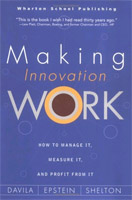In their book, Making Innovation Work: How to Manage It, Measure It and Profit from It (Wharton School Publishing), authors Tony Davila, Marc J. Epstein and Robert Shelton make the case that innovation is not a one-time event, but a process that must be continuously managed, measured and carried out in all a company’s products, services and business functions. Using specific companies as examples, and drawing on existing research as well as their own experiences in the field, the authors demonstrate what works and what doesn’t, and offer advice on how to consistently maximize the value of innovation investments. Below is an excerpt from Chapter Two, entitled Mapping Innovation: What Is Innovation and How Do You Leverage It?
A New Model of Strategic Innovation
One of the most common misconceptions is that innovation is primarily, if not exclusively, about changing technology. Mention innovation to many business-savvy CEOs, and they envision R&D labs where engineers and scientists are developing the next new technology. However, innovation is not just about changing technologies.
High-performing companies innovate by leveraging both new business models and improved technologies. In Chapter 1, “Driving Success: How You Innovate Determines What You Innovate,” we described the business model innovation of Dell and the technology and business model innovations of Apple. There are plenty of other examples. eBay developed a new online business model for auctions using readily available, albeit fairly new, Internet technology. The retail giant Wal-Mart currently dominates its retail space, and has used commercially available computer communication technologies to hyper-integrate its supply chain with suppliers, thereby creating a new business model with significant cost savings.
Nick Donofrio, lead researcher at IBM, said, “We define ‘innovation’ as our ability to create new value at the intersection of business and technology. We have to have new insights. We have to do things differently. We cannot rely just on invention or technology for success.”
Even the stodgy, asset-intensive steel industry has seen innovation of this type. Nucor Steel transformed the steel industry when it developed a production technology to turn old metal into steel, and changed its business model to capture maximum value. Nucor’s new business model focused on relatively small volume production of high-value products, effectively reversing the heritage industry model of large-scale production runs of commodity products. The combined effect of the technology change and the business model shift sent ripples of change throughout the industry.
Rarely does a technology change occur without also causing a change in business processes. The reverse is also true. Both innovations go together and have to be thought and implemented as a whole. For instance, a new technology may require changes in the way the manufacturing facility organizes its work, or a change in how marketing communicates with the company’s customers.
One of the best-known examples of business model driven innovation is the history of the auto industry in the first half of the 20th century. Initially, all cars were manufactured in shops, and were very labor-intensive; each unit was a unique piece of artisan work. The first radical change in the business model came with Henry Ford’s move toward standardization and applying the concepts of a production line to the car industry. While Ford used new technologies — mainly process technologies to increase the efficiency of its production lines and its supply chains — the radical innovation came from the business model dimension, where the whole concept of the auto industry was turned upside down: from shop work to production line, from product performance to product cost, from customization to standardization, from assembly to vertical integration, from niche market to mass market.
The second transition came when General Motors again redefined the business model, this time at the expense of Ford. Alfred Sloan relied on even less technology than Ford to execute its business model transformation. His ingenuity played through the business model and management knowledge (soft technology, if you want) to overtake Ford. General Motors segmented the market, offered differentiated functionality to each segment, and introduced flexibility in the production process to offer a richer product line.
Successful organizations combine technology change and business model change to create innovation. In addition, to successfully integrate a robust model of innovation into the business mentality, the CEO and the leadership team must balance both the business and technology elements of innovation.
[There are six levers for change. In the business model innovation these include value proposition, supply chain and target customers. In technology innovation, they include product and services, process technologies and enabling technologies.]
Business Model Change
Business models describe how a company creates, sells, and delivers value to its customers. The three areas where business model change can drive innovation are:
- Value proposition: What is sold and delivered to the market.
- Supply chain: How it is created and delivered to the market.
- Target customer: To whom it is delivered.
These are the fundamental elements in every business strategy and the logical focal points for innovation.
Value Proposition
Changes in the value proposition of the product or service — essentially, what you sell and deliver to the marketplace — may be an entirely new product or service or an expanded proposition for an existing offering. For example, several brands of toothpaste have recently added whitening to their ever-growing list of delivered values such as cavity protection, breath improvement, and tartar control. Likewise, automobile manufacturers often add new features to their car and truck models, or they provide enhanced after-purchase services. In the world of computing and information management, IBM is moving away from a product-driven value proposition and has tightly bundled a wide range of services with its products.
In fact, services have become a major part of its business; in 2003, 48% of IBM’s revenues came from providing services, generating 41% of profits. IBM’s acquisition of PricewaterhouseCoopers (now IBM Global Services) and the growth of hosted applications within the OnDemand initiative are all strategic moves towards enhancing the service aspect of IBM’s product offering. Amazon changed its service offering to become an online mall or retail platform selling goods from other retailers on its site, such as clothes from the Gap, Nordstrom, and Eddie Bauer and sporting goods with more than 3,000 brands.
Supply Chain
The second element of innovative business model change is the supply chain — how value is created and delivered to the market. Changes to the supply chain are usually “behind-the-scenes,” changes that customers typically do not see. This type of business model change affects steps along the value chain, including the way an entity organizes, partners, and operates to produce and deliver its products and services. In the 1980s, when Sun Microsystems worked with outside organizations as strategic partners to provide value-creating activities, it created a new approach to outsourcing, and a big competitive advantage — but you could not discern it explicitly in its products.
Also, supply chain changes can result from combining parts of the supply chain that typically are provided by different companies. For example, when General Electric began to couple service contracts with its manufactured electric turbines, it created new synergies and value in its part of the supply chain. Customers bought the package of hardware and service, and GE was able to secure above-average margins for the industry. This was a significant innovation with major market implications; the business model changed to include hardware and service as bundled products, requiring companies in the space to master both aspects to remain competitive.
Innovations may also come from redefining relationships with suppliers. Toyota redefined this relationship in the car industry during the 1970s. Toyota changed from the traditional confrontational relationship between suppliers and automakers to a collaborative relationship where suppliers participated in the successes and failures of the automaker. Innovations can also come from carefully managing relationships with complementary assets. The success of Microsoft’s entry in the gaming market with its Xbox was dependent on the growth of game developers that would develop applications for Xbox as well as the growth of the Xbox itself.
Target Customer
Changes in to whom you sell — the target customer segments — usually occur when an organization identifies a segment of customers to whom it does not currently direct its marketing, sales, and distribution efforts that would consider its products and services valuable. For example, developers of the nutritional bars originally targeted athletes and extreme sports participants. Later it was realized that other customer segments — such as women — were a potentially large set of customers for the value of nutritional bars. With relatively small changes to the ingredients, packaging, and advertising, the potential market for the bars was increased several-fold.
Dockers, a clothing brand of ready-to-wear clothing, specifically targeted the “lower-maintenance” customer group with its stain-fighting and no-iron khakis. Dockers targeted these fashion-challenged men with its signature khakis, a departure from its usual targeted segment of fashion-conscious men, and experienced renewed growth.
While innovation driven by changes to the targeted customers is not as common as changes to the supply chain or value proposition, it is an important lever for innovation and should not be overlooked when companies are looking for opportunities to innovate.
These three levers — the value proposition, supply chain, and the target customer — are the basis for creating business model innovation that leading companies such as Dell, Nucor Steel, and GE have used to their advantage.
Technology Change
Sometimes new technologies are a major part of an innovation, and they stand out and garner significant attention. Other times, the new technologies are hidden out of sight and can only be seen by the technical people servicing them. Either way, technology change can fuel innovations in three distinct ways; namely in
- Product and service offerings
- Process technologies
- Enabling technologies
Product and Service Offerings
A change to a products or service that a company offers in the marketplace — or the introduction of an entirely new product — is the most easily recognized type of innovation because consumers see the changes first-hand. In today’s fast-changing market, consumers have come to expect significant and recurring technological innovation of this type. Consumers have been conditioned to expect product innovation to such an extent now that it is common for people to time their purchases — waiting for the release of a new model of an MP3 player with additional features and increased storage capacity.
Other examples of product-based technology innovation include the frequent new features released on mobile phones and automobiles. New “blockbuster” prescription drugs are also the result of this type of innovation. McDonald’s introduction of low-fat oil enabled it to capture a new market segment — health-conscious consumers — with the same product and service offering. The new oil does not affect the taste (or perceived quality) of its offering but makes the product attractive to an entirely new segment, and possibly enhances the attractiveness to existing customers. McDonald’s pioneered this approach to fast food, and it has enabled the company to maximize the value out of its existing product and service offering.
While this type of innovation is very important and can have a significant impact on company success, it is not the only form of technological innovation.
Process Technologies
When we think about technology innovation, we think about innovation that drives the performance of the products or services that the company offers. For example, when we think about memory chips we think about capacity, access speed, or even energy consumption. Product innovation comes to mind because it quickly translates into functionality that the customer can value and price. But product innovation is only one application of technology.
Changes in the technologies that are integral parts of product manufacturing and service delivery can result in better, faster, and less expensive products and services. These process technology changes are usually invisible to the consumer but often vital to a product’s competitive posture. Examples include food processing technologies, automobile manufacturing, petroleum refining, electricity generation, and manufacturing in every industry. Process technologies also include the materials used in the manufacturing, because manufacturing and materials are intimately connected. For service providers, the process technologies are those elements that allow the service to be delivered — the equipment that sends and receives the telephone signals that make up phone service, the package sorting stations, and delivery trucks that allow packages to be delivered by express package service companies, and the airplanes and airports that provide air transport services. For products and services, process technologies are an essential part of the innovation equation.
Companies continually strive to make changes to the process technologies that could reduce cost and improve the quality of existing products or services. This is especially true in commodity products or services where it is increasingly difficult to differentiate the product or service; in commodities, cost is often the only way to compete. Certainly the electric utility industry feels this cost pressure in production, transmission, and distribution of electricity. However, the competitiveness of all products and services are benefited by improvements in process technologies.
Enabling Technologies
A third source of technology innovation resides in what we call enabling technology. Rather than changing the functionality of the product or the process, enabling technology enables a company to execute the strategy much faster and leverage time as a source of competitive advantage. For example, information technology facilitates the exchange of information among the various participants in the value chain. Closer communications speeds up business processes from product development to supply chain management.
Though the least visible to customers, change in enabling technologies, such as information technologies, can be very important because they help ensure better decision-making and financial management. For example, Wal-Mart has made important changes to its enabling information management technologies, with significant improvement in its ability to track and manage its partners, the supply chain, and finances.
This new model of innovation requires integrating the management of business models and technologies inside the company. But this integration does not always occur. Facing increasingly effective competition, Intel in 2004 was spending billions on developing and commercializing technology innovations but not apparently on business model innovation. The question asked in Silicon Valley was not whether Intel had the right technologies but did it have the right business model to compete in the years ahead. It appeared to many that business model and technology innovation had become separated. Traditionally, organizations create and manage the changes to business models in parts of the organization that are far removed — physically and culturally — from where the technology change is managed. Successful innovation depends on the integration of the mental models and the activities regarding business models and technology management.



